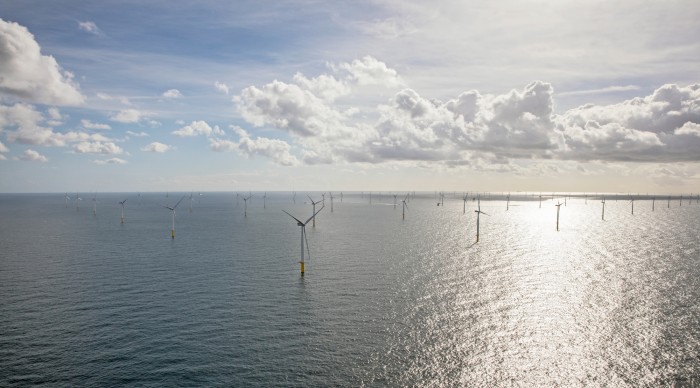What the U.S. Could Learn from the Dutch on Climate Change

Earlier this month, the Netherlands completed one of the largest offshore wind farms in the world, as an accelerating wind boom finally helps the country make real progress on its renewable energy goals.
The 600-megawatt Gemini wind park, operating 150 turbines in the North Sea, will serve some 1.5 million citizens. Several other major offshore wind farms are under development as well, which will collectively push total wind capacity to nearly 4.5 gigawatts by 2023 (see “The Wind Fuels the North Sea’s Next Energy Boom”).
“As a country we were heavily dependent on fossil fuels, and our way to renewables has been bumpy,” Sharon Dijksma, the nation’s minister for the environment, told MIT Technology Review this week. “So this government decided that we needed to step up the pace.”
Indeed, the Netherlands had to take bigger swings to meet a binding requirement to reach 14 percent renewable energy sources by 2020 under a European agreement, as well as emission reduction targets under the Paris climate accords. Clean energy sources currently account for around 6 percent of generation there, lagging well behind most of its European peers.

“When you have enough gas in the ground, you’re not so much looking for anything else,” Dijksma said. “We were spoiled by natural resources.”
Offshore wind was the logical technology bet for a nation that doesn’t have a lot of sun or much undeveloped land, but does sit adjacent to the breezy North Sea.
Dijksma highlighted the nation’s recent renewable strides at the Climate is Big Business summit this week in San Francisco, one stop in a longer "California mission" to boost collaboration with the state on climate and energy issues.
During her presentation, she stressed that the green transformation is creating rather than undermining economic opportunities, highlighting a McKinsey & Co. report that found that cutting 95 percent of carbon emissions would add some 45,000 jobs over the next two decades. The wind projects alone are expected to add 10,000 jobs by 2020. In addition, the level of government support required to push projects forward is rapidly falling.
Amid the growing amount of wind power in the Netherlands and neighboring countries, the nation announced in January that all of its electric trains now run on 100 percent wind power, a year ahead of schedule.
When it comes to business opportunities from climate change, the Netherlands’ greatest competitive advantage is on the adaptation side. The low-lying nation has decades of experience building dikes, dams, and other infrastructure to fortify it against flooding, particularly following the 1953 North Sea storms that killed nearly 2,000 citizens. Urban planners looking for ways to counter rising sea levels in coastal cities around the world have studied the creative water diversion and storage work done in Amsterdam and Rotterdam, including sunken city plazas and parking garages that convert into water basins during flooding.
Likewise, the Dutch engineering company Arcadis has consulted with U.S. cities in the aftermath of natural disasters, working to bolster flooding protections in New Orleans following Hurricane Katrina and New York after Superstorm Sandy (see “Life Below Sea Level in the New Age of Climate-Change Engineering”).
But projections for the rise in sea level have climbed sharply, posing a continual challenge for a nation where around a quarter of the land is below it. Notably, that same area is responsible for 60 percent of gross domestic product.
In the event of a big flood, “we would have a massive breakdown, it would tear the country into pieces and the economy would collapse,” Dijksma said. “So this Armageddon scenario has to be fought against.”
The nation has a long-term plan in place, and is setting aside billions for infrastructure projects. Those include ongoing efforts to protect the shores and inlands from flooding risk, including widening river spillways, sculpting valleys, and building dunes.
As the Netherlands invests heavily to hold back existential climate threats and overhaul its energy system, it’s all the more disturbing to hear the U.S. president question the reality of climate change and threaten to pull out of the Paris agreement.
“It would be a huge blow for all of us if that were to happen,” Dijksma said. “They are the second biggest polluter worldwide, so there’s a question of noblesse oblige, pardon my French, at stake.”
Keep Reading
Most Popular
Large language models can do jaw-dropping things. But nobody knows exactly why.
And that's a problem. Figuring it out is one of the biggest scientific puzzles of our time and a crucial step towards controlling more powerful future models.
The problem with plug-in hybrids? Their drivers.
Plug-in hybrids are often sold as a transition to EVs, but new data from Europe shows we’re still underestimating the emissions they produce.
Google DeepMind’s new generative model makes Super Mario–like games from scratch
Genie learns how to control games by watching hours and hours of video. It could help train next-gen robots too.
How scientists traced a mysterious covid case back to six toilets
When wastewater surveillance turns into a hunt for a single infected individual, the ethics get tricky.
Stay connected
Get the latest updates from
MIT Technology Review
Discover special offers, top stories, upcoming events, and more.